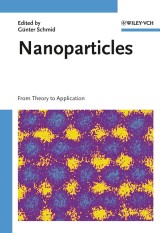Details
Nanoparticles
From Theory to Application1. Aufl.
|
156,99 € |
|
| Verlag: | Wiley-VCH (D) |
| Format: | |
| Veröffentl.: | 06.03.2006 |
| ISBN/EAN: | 9783527604043 |
| Sprache: | englisch |
| Anzahl Seiten: | 444 |
DRM-geschütztes eBook, Sie benötigen z.B. Adobe Digital Editions und eine Adobe ID zum Lesen.
Beschreibungen
<p>An introduction to the science of nanoparticles, from fundamental principles to their use in novel applications.</p> <p>As a basis for understanding nanoparticle behavior, the book first outlines the principles of quantum size behavior, nanoparticles architecture, formation of semiconductor and metal nanoparticles. It then goes on to describe the chemical syntheses of nanoparticles with defined characteristics, their structural, electrical and magnetic properties, as well as current methods to monitor these properties.</p> <p>Among others, the following nanoparticle-based applications are discussed:</p> <ul> <li>Single-electron devices</li> <li>Ultra dense recording media</li> <li>Bioelectronic devices and sensors</li> <li>Labeling of proteins, nucleic acids and other biomaterials.</li> </ul> <p>With its clear structure and comprehensive coverage, backed by numerous examples from the recent literature, this is a prime reference for chemists and materials scientists working with and developing nanoparticle systems.</p>
1. General Introduction (G. Schmid). <p>2. Quantum Dots (W. Parak, <i>et al</i>.).</p> <p>Introduction and Outline.</p> <p>Nanoscale Materials and Quantum Mechanics.</p> <p>From Atoms to Molecules and Quantum Dots.</p> <p>Shrinking Bulk Materials to a Quantum Dot.</p> <p>Energy Levels of a (Semiconductor) Quantum Dot.</p> <p>Varieties of Quantum Dots.</p> <p>Optical Properties of Quantum Dots.</p> <p>Some (Electrical) Transport Properties of Quantum Dots.</p> <p>3. Syntheses and Characterizations.</p> <p>Semiconductor Nanoparticles.</p> <p>Synthesis of Metal Nanoparticles.</p> <p>4. Organization of Nanoparticles.</p> <p>Semiconductor Nanoparticles.</p> <p>Metal Nanoparticles.</p> <p>5. Properties.</p> <p>Semiconductor Nanoparticles.</p> <p>Electrical Properties of Metal Nanoparticles.</p> <p>6. Biomaterial-Nanoparticle Hybrid Systems: Synthesis, Properties, and Applications (E. Katz, <i>et al</i>.).</p> <p>Introduction.</p> <p>The Synthesis and Properties of Biomaterial-Functionalized Nanoparticles.</p> <p>Biomaterial-Functionalized for Controlled Chemical Reactivity.</p> <p>The Aggregation of Biomaterial-Functionalized Nanoparticles.</p> <p>Assembly of Biomaterial-Nanoparticles Architectures on Surfaces.</p> <p>Functional Biomaterial-Nanoparticle Structures on Surfaces for Sensoric and Electronic Applications.</p> <p>Biomaterial-Functionalized Magnetic Particles.</p> <p>7. Conclusions and Perspectives (All Authors).</p>
“…impressive…” (<i>Ultramicroscopy</i>, Vol. 104, 2005) <p>"…a homogeneous, integrated, well-crafted, and highly readable volume…I strongly recommend that instructors take a serious look at this text…it is also of extraordinary value as a resource for the established researcher…" (<i>Journal of the American Society</i>, December 1, 2004)</p> <p>"This information resource would be of a great value for graduate students and scientists working with nanoparticle systems." (<i>E-STREAMS</i>, November 2004)</p>
<b>Gunter Schmid</b>, Professor em. at the University of Duisburg-Essen. His research is focused on the interface between chemistry an physics, covering clusters, nanoparticles and nanosciences. He published about 350 papers and edited several books on nanomaterials and nanotechnology. He acts as a member in several editorial boards, e.g. for <b>Small</b> and <b>Advanced Functional</b> <b>Materials</b>. In 2003 he received the prestigious Wilhelm-Klemm award of the German Chemical Society.
<b>A</b>n introduction to the science of nanoparticles, from fundamental principles to their use in novel applications.<br /> As a basis for understanding nanoparticle behavior, the book first outlines the principles of quantum size behavior, nanoparticles architecture, formation of semiconductor and metal nonoparticles. It then goes on to describe the chemical syntheses of nanoparticles with defined characteristics, their structural, electrical and magnetic properties, as well as current methods to monitor these properties.<br /> Among other, the following nanoparticle-based applications are discussed: <ul> <li>Single-electron devices</li> <li>Ultra dense recording media</li> <li>Bioelectronic devices and sensors</li> <li>Labeling of proteins, nucleic acids and other biomaterials.</li> </ul> <p>With its clear structure and comprehensive coverage, backed by numerous examples from the recent literature, this is a prime reference for chemists and materials scientists working with and developing nanoparticle systems.</p>
"Günter Schmid, the Editor of <i>Nanoparticles</i>, is successful in securing the participation of prominent leading experts; he also excels in integrating the chapters in such a way that there is no disjointedness between the different topics which is a great advantage for the reader."<br /> —Dr. Andrey L. Rogach, <i>ChemPhysChem</i><br /> <br /> ",,,this book is useful for chemists interested in novel methods of wet-chemical nanoparticle synthesis but also for anyone looking for an introduction into the understanding of the electrical, optical and magnetic properties of nanoparticles."<br /> —Frank Einar Kruis, Univeristy of Duisburg-Essen, <i>Particle Characterization & Particle Systems</i>, Vol.21, No. 3, October 2004<br /> <br /> "Biogenetic magnetite provides great inspiration to laboratories active in nanotechnology, as for instance the book by Günter Schmid testifies to."


















